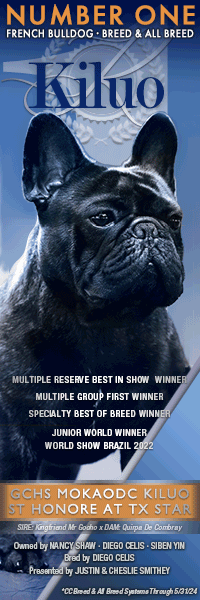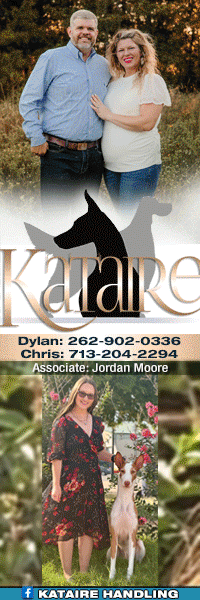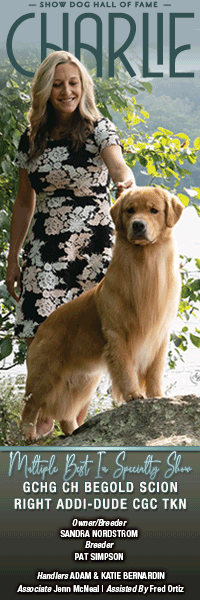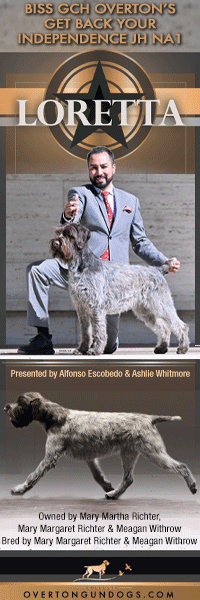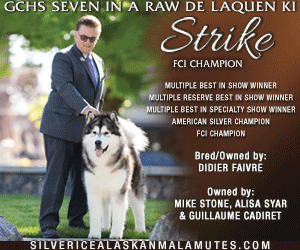Kromfohrlander-The Youngest Breed in Germany
212 – July, 2010
text and illustrations by Ria Hörter
The Youngest Breed in Germany

After about 10 years, Schleifenbaum and Borner were able to present dogs with a uniform appearance. Two dogs from the kennel von der Aragorner Hoehle are pictured.
Many stories describing the history of a breed proudly start with: “This breed was known in Roman times” or “The ancestors of this breed can be seen on Egyptian tombs.” We could start the history of the Kromfohrländer with: “This breed is by far the youngest breed in Germany” or “This breed is the result of a meeting between two neighboring dogs shortly after the Second World War.” And indeed this breed is the result of a chance hit with two leading actors, a French pointing dog – probably a Grand Griffon Vendéen – and ‘Fiffi’, a black-and-white female Fox Terrier without a pedigree. It is not sure whether the Griffon was purebred or not. If nothing had happened afterward, the puppies would just have been mongrels, and if they were lucky, they might have found good homes. End of story.
Those two dogs, however, became the ancestors of a new breed in Europe.
American Soldiers
At the end of the Second World War, a dog was taken eastward by American soldiers quartered in western Germany. In the county of Siegerland – in the territory of Krumme Furche to be precise – the dog deserted and found a new home with Mrs. Ilse Schleifenbaum. She cleaned the dog up and identified him as a Grand Griffon Vendéen, a French pointing dog. Others claim that he was a ‘Breton Griffon’, a pointing dog originating from Brittany on the west coast of France.
Schleifenbaum named the drifter ‘Peter’. One day, Peter seized the opportunity of meeting his neighbor, a Fox Terrier bitch owned by Mrs. Schneider. He not only met her, but mated her. The result was a litter of yellowish brown-and-white dogs. It was quite difficult for the family to raise the puppies due to the shortage of food. Looking at them, it was clear from the beginning that the pups shared many characteristics, and at the same time did not resemble any other breed. This was remarkable, the litter being a mating between two completely different breeds. The little dogs were cute; they were not too big, but robust, and they proved to be excellent companion dogs –?inquisitive and loyal. It was one of the reasons Ilse Schleifenbaum decided to breed more litters of these dogs, at the same time trying to create a new breed. Later, two bitches from the first litter – ‘Zottel’ and ‘Hexe’ – were entered in the stud book of the German Kennel Club.
Uniform Appearance
Schleifenbaum was assisted in her attempts by Otto Borner, who tried to set up a second line of the new breed. Both worked hard and at one time they owned more than 20 dogs. Promoting the new breed was not easy in those years after the Second World War. Germany had suffered heavy bombardment and getting enough food for humans was difficult and expensive, let alone for animals. Ilse Schleifenbaum promoted the breed by visiting national dog shows and after about 10 years the two breeders were able to present dogs with a uniform appearance – quite an achievement in such a short time. The kennels, vom Wellersberg, owned by Schleifenbaum, and vom Lenneberg, owned by Borner, formed the cornerstones of the Kromfohrländer breed.
It’s not difficult to guess where the breed’s name comes from. Krumme Furche or Krom Fohr (dialect; “crooked furrow” in modern German) is a region in the county of Siegerland; ‘länder’ denotes ‘coming from’. Schleifenbaum and her husband owned a summer house in the Krumme Furche. Some dog fanciers did not accept the new German breed; they named the dogs ‘Sieger Mongrels’. It is said that somebody tried to poison one of Schleifenbaum’s winning dogs at the dog show in Oldenburg in 1956.
In 1955, 10 years after the first litter, the breed was recognized by the German Kennel Club (VDH) and by the FCI. Schleifenbaum and Borner wrote the first breed standard which was altered in 1968 and 1986. The most recent FCI breed standard dates from 1998.
Ilse and Otto

Mrs. Ilse Schleifenbaum is pictured with the bitch ‘Dina vom Wellersberg’ (left) and the male ‘Fax vom Wellersberg’.
As a young woman, Ilse Schleifenbaum (1897-1991) was a professional piano player. She travelled extensively and met many other celebrities while touring in Europe. The Second World War changed her life completely; she married, had children and stayed at home. She must have been a lively woman, because every day she took the puppies of the first litter to the town of Siegen in her Volkswagen. She once said in an interview, “I had to make the breed known among the people”. We can be sure that she attracted a great deal of attention in those days.
As a young boy, Otto Borner began his breeding career with mice and rabbits; he became involved in dogs after the war. The German Kennel Club had to be rebuilt and Borner was one of the fanciers involved in this job. With Schleifenbaum’s dogs, it was love at first sight, and creating a new German dog breed was just what he wanted to do.
With help from friends and neighbors, a club was formed, called the Förderverein, just for promoting the breed. At that time, Schleifenbaum and Borner had long discussions about the breed, for example about whether or not it should have a beard. Schleifenbaum’s husband used to tease his wife saying, “You and your dogs…” and “… if you want to breed, you must bring the money…”
I’m convinced that being so close to the German Kennel Club helped Borner make his dream come true. Schleifenbaum travelled several times to the German Kennel Club in Dortmund. She was quite determined and presented ‘Peter’ and seven of his offspring to the gentlemen of the KC.
Although Schleifenbaum didn’t like the idea of an official breed club, one had to be formed after the official recognition in 1955. In the same year, the breed was presented at the international dog show in Dortmund.
The club’s bylaws stated that breeding should be a hobby exclusively. It was also agreed that the highest purpose should be breeding a healthy dog with steadfastness of character.
Ilse Schleifenbaum was chairman of the Rassezuchtverein der Kromfohrländer e.V. until 1980. ‘The mother of the Kromfohrländer’ died in 1991 at 94 years old; she had bred about 400 dogs. The breed club still exists and is very active.
In the first years, there were only two breeders, but in 1969 other German breeders – for example, the kennels vom Antareshof, vom Dieke and vom Weddern – got involved. The second generation of breeders, Countess Wanda von Westarp, Werner Rahmen and Helmut Koschnicke, broadened the base. In the first generations Schleifenbaum and Borner had no choice but to inbreed their dogs. The Countess von Westarp (born 1919) is still around and has written some books about the breed.
From 1955 to 1986, 645 Kromfohrländers were entered in the German stud book.

The Kromfohrländer is still a rare breed, even in its homeland of Germany. Dogs from the kennel ‘von der Napoleonsnase’.
Finland
Maria Akerblöm, a well-known breeder in Finland, visited a dog show in Oldenburg (northern Germany) in 1956. She fell in love with the breed and after meeting Schleifenbaum bought a bitch from her kennel, Nisba vom Wellersberg, as well as some other dogs. She became the first Kromfohrländer breeder outside Germany. Under the affix av Ros Loge, her first litter of six puppies was born in Finland in 1962. After 1980, Akerblöm donated her German friend Schleifenbaum a companion, a bitch named Silvä.
Today dogs from Germany are still sold to Finland, the second homeland of the Kromfohrländer. The contact between the two countries became a lot easier after the removal of the strict quarantine rules. Ilse and Maria became friends for life and it has to be mentioned that the Finnish are breeding beautiful Kromfohrländers. It is said that they have the best stock in the world. The first Specialty for Kromfohrländers was held in Finland in 1984.
Companion Dog
The Kromfohrländer is still a rare breed, even in its homeland. In 1999, the 2,000th Kromfohrländer was registered in Germany. Apart from Finland, the breed can be found in Switzerland (1970), the Netherlands and Denmark. There should be a few in the U.S. The breed was recognized by the United Kennel Club in 1996. Today there are about 1,800 Kromfohrländers worldwide.
Looking at pictures of the Kromfohrländer, it’s obvious that this is a young breed. Remembering that, it’s remarkable that most dogs, although there are rough- and smooth-haired varieties, are more or less of the same type. Apart from the coat, the distinction between the two varieties is the beard; the smooth-coated is beardless. In the beginning, breeders were confronted with the usual problems of a (new) breed: ear carriage varies and the first cases of cataract were reported.
The temperament of the Kromfohrländer is lively, loyal and obedient. The breed standard says, “Aggressiveness and timidity not desired.” It’s not difficult to train this dog for agility, obedience or flyball. The breed is watchful, alert, intelligent and devoted to its family, which makes the Kromfohrländer an ideal companion dog. Some still possesses a moderate hunting instinct inherited from their terrier/pointing-dog ancestors, but overall the breed does not roam. One of the typical features of the breed is that it does not smell at all. The coat needs little in the way of care.
People speaking or writing about the breed sometimes use the name ‘German Terrier’; fanciers call him simply ‘Kromi’.
Short URL: https://caninechronicle.com/?p=1325
Comments are closed


